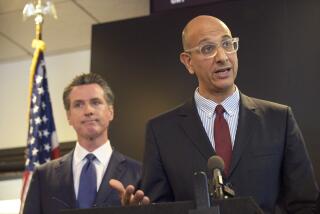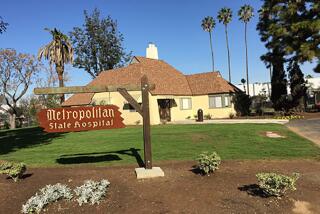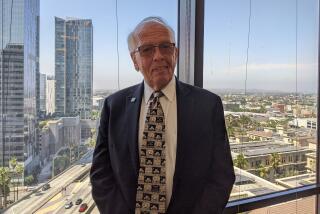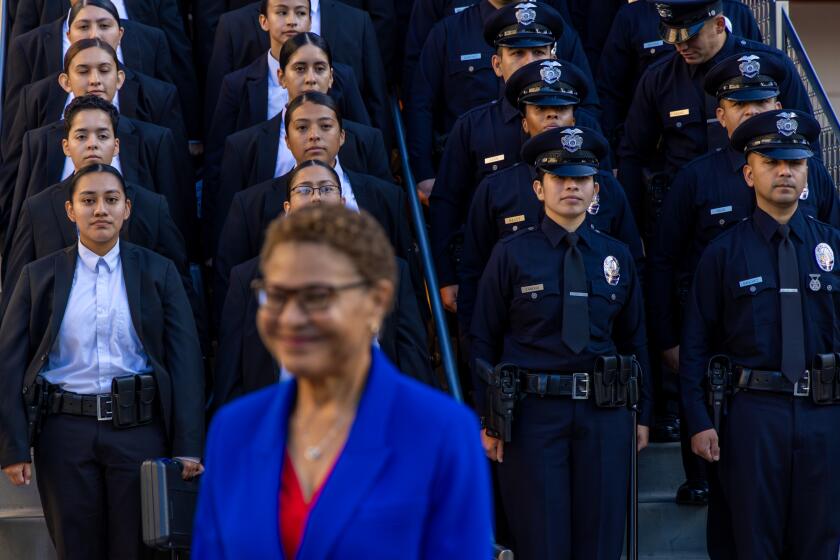LOS ANGELES TIMES INTERVIEW : Ronald Kaufman : Ensuring L.A.’s Public Health Through County--USC Hospital
- Share via
County-USC is the foundation for the entire health-care delivery system. If it didn’t exist, emergency services for this region would be markedly under-served. This will be a difficult period because there will be ethical considerations on the part of physicians such as, ‘How can we ethically turn away patients?’ I’ve been in talks with private hospitals, to see how we can better deliver care for the region. A lot of hospitals view our survival as essential to their well-being.
County-USC Medical Center, a white, Art Deco structure, is perched on a hill just east of downtown. But few Angelenos whizzing by on the Golden State Freeway realize how important this hospital is to their personal well-being.
One of only 11 trauma centers in Los Angeles County, the medical center is an important nexus for two-thirds of county residents. Located in the most densely populated section of the city, the hospital provides 24-hour emergency service and secondary medical care to indigent residents. By doing so, it offers an insurance policy for the entire city by assuring that uninsured patients do not jeopardize the medical capacity of surrounding private hospitals.
As one of the nation’s largest public hospitals, each year County-USC’s medical staff delivers 10,000 babies, moves 250,000 patients through its emergency room, treats almost half the city’s AIDS sufferers and juggles the needs of 5,000 daily visitors to its out-patient clinics. In spite of its importance to the city, County-USC’s name has repeatedly surfaced on the hospital closure list--most recently during the embittered budget battle. Though saved from the chopping block by a last-minute federal bailout, the hospital is still endangered. The chief of its medical staff, Dr. Ronald L. Kaufman, must navigate in a world of declining resources, while maintaining the same level of medical service.
Groundbreaking for a smaller facility is scheduled for next year, but now Kaufman must address the medical needs of 800,000 patients annually, marshaling the skills of his 450 full-time faculty physicians; 900 interns and post-graduate residents and 1,500 other physicians. Any faulty decisions could have a domino effect.
Kaufman grew up in the Pico district, where his parents rebuilt their lives after escaping Nazi concentration camps. Kaufman received his medical degree from UC Irvine, and did his rheumatology residency at County-USC, followed by a 12-year stint at Rancho Los Amigos Medical Center. He has been with County-USC since 1989.
Trim and toned, Kaufman’s fast-paced gait around the 72-acre medical hub belies his 50 years, but his acquired wisdom surfaces as he excitedly explains the integration of the various facilities. The sloping knoll is also home to USC’s medical school, the Doheny Eye Institute, the Norris Cancer Hospital and several other satellite research centers. His friendly relationship with all segments of his medical clan is readily apparent as he walks around; and as a first-generation Angeleno, Kaufman is comfortable with a multiethnic patient population often neglected by mainstream medicine.
The father of two daughters, Kaufman lives in Pasadena with his wife, Barbara, a Yoga teacher. Like other healers, Kaufman has taken to heart the inscription above the hospital’s entrance: “The doctors of the staff give their services without charge in order that no citizens of the county shall be deprived of health or life for lack of such care and services.”
*
Question: Who do you primarily serve?
Answer: Our biggest population are people needing emergency care. We are the largest provider for emergencies and trauma services in the region and the busiest emergency room in the country.
The patients seeking ongoing care come to us for two reasons. They may not have insurance coverage, so they are referred to us as indigent. They are welcomed here and we have an obligation to take care of them. The other group includes those who have insurance but are seeking our expertise and specialty services.
*
Q: What do you consider to be the area you serve?
A: If you draw a circle around us, within a 15-mile radius, approximately 6 million people--or, 60% of the entire population of L.A. County lives within those boundaries. Outside of that area, few hospitals are able to serve this population. To the east, all the way to the county line, there is nothing; to the west, there is Cedars-Sinai, and to the south, past USC’s main campus, you have nothing until you reach [Martin Luther] King Hospital.
*
Q: How does L.A. County-USC fit into our health system?
A: L.A. County-USC is the foundation for the entire health-care delivery system. If the medical center didn’t exist, the emergency services, especially for this immediate region, would be markedly underserved. A recent study . . . showed this area has a huge need because the population is so dense. If County-USC didn’t exist, those patients wouldn’t have access and likely die in transition to other hospitals.
Another reason we are the infrastructure is because smaller, local hospitals have grown up knowing that specialty services are located on this campus and, therefore, they tend to focus on primary and secondary services.
*
Q: How do you plan to manage the scaling back of medical services?
A: Our goal will be to provide services to those who can benefit the most--which are those who have such complex and severe medical problems that their care cannot be deferred. It is really going to be a trying time, because there will be patients who probably will not be able to receive the kind of care they like--or receive any care at all. This is going to be a difficult period, because there will be ethical considerations on the part of physicians such as, “How can we ethically turn away patients?”
*
Q: What are your physicians saying about the proposed changes?
A: The turmoil we’re experiencing at L.A. County-USC is no different from the turmoil that is occurring at hospitals such as UCLA, Johns Hopkins or Cedars-Sinai. This turmoil and change is a societal-wide issue. But, it is unavoidable, because we have to meet the challenge, we have to be innovative with the solutions that we bring to the problems.
However, I’m pleased to say that there is tremendous cooperation from my staff and people in training to try and do things that they would never have thought about doing before, while they are continuing to deliver the kind of services that patients need.
One of the unique things about L.A. County-USC Medical Center is its ability to integrate its faculty across both the public and private medical-research centers--which enhances patient care. We have 450 [full-time] faculty [positions] whose services are actually provided by between 650 and 800 individuals. Thus, the quality of service that the public patients and the uninsured receive is much higher had the county attempted to do this without a partnership.
*
Q: With increasing economic pressures, how are you addressing a need to avoid a repeat of the the 1994 hostage shooting incident, when emergency-room physicians were injured?
A: Since that incident, security has changed. Everybody gets stopped, monitored and searched.
*
Q: How important are the unions in the restructuring process?
A: Our union, the AFL-CIO, played a very positive role on a national level and they were influential with President Clinton. The unions have a history of trying to do what is best for their members, and the unions understand that we have fewer resources and they have to balance the need to protect members against the county’s financial realities.
I believe the unions will be a willing partner in trying to improve the quality of services by trying to improve productivity and efficiency.
*
Q: What kind of effect will the GOP’s Medicare and Medi-Cal-Medicaid proposals have?
A: It won’t have much immediate direct impact on us. Patients with Medi-Cal, when they have a choice, chose facilities other than ours. However, I do believe that, over the long term, as financial support for Medicare changes, we may be seeing an increase in Medicare patients because they may no longer have access to care at other facilities.
However, the Medicare program is potentially extremely damaging . . . [because] it is going to lessen the financial resources going to facilities like County-USC, because the reimbursements for the facilities are going to go down. However, as patients with Medicare and Medi-Cal come to us, even though the reimbursement is lower, it is higher than for the patients who have no reimbursement at all. So, it actually is sort of good news for public hospitals, but it is going to require us to cut back costs.
*
Q: What is missing from the current health debate?
A: There is a lot of talk on preventable care and there is no disagreement that we have to do more in the way of “primary and preventive care.” But there is not enough debate defining how you build an entire system.
We will not be able to avoid emergency or trauma care, nor avoid the need for certain kinds of surgical procedures or treatment of various kinds of disease. These procedures require a lot of technology and can only be done at major medical centers.
*
Q: The city of Rochester developed its own health-insurance plan that extended care to all its residents. Could that model work for Los Angeles?
A: It is essential for the people in this region to bring together that kind of collaboration. One of the underlying assumptions in our replacement construction project is that we need to partner with not only private physicians, but with private hospitals. Through the last several years, I’ve been in discussions with multiple private hospitals, trying to see how we can better deliver care for the region. There are a lot of hospitals that view our survival as essential to their well-being and, therefore, we must join together.
Rochester took a very innovative way of developing their health-care system. The collaboration of the health-care providers with insurance companies and with the business interests helped Rochester build a system that met the needs of the community. They did not overbuild or allow excess capacity to occur, and they thereby [built] a system that logically works for the population.
The problem with L.A. is we have excess capacity in terms of distribution of available services. For example, some hospitals have empty beds, which are referred to as “ward beds or standard med-surgical beds.” However, these beds are not able to provide intensive care. Currently, those beds are being moved to out-patient settings, but those hospitals cannot replace the services we provide.
What we need to do is better design a health-care system, given the building blocks we have. We need to centralize specialty and emergency services; distribute primary and preventable care, and provide appropriate care at appropriate locations--which will require a lot of planning.
*
Q: During the recent budget crisis, did you think County-USC would close?
A: Essentially, up to this point, every single county hospital has been listed for closing at one time or another, but the closure of any county hospital is going to present its own problems. From a political and financial sense, you can do just about anything, but it would have been a catastrophic decision for the health status for the entire Los Angeles County population.
As I mentioned, not only does 60% of the population live within a 15-mile radius, but 60% of the uninsured population live within a 10-mile radius. So you take out this facility, those patients have no access to health care--which is an unimaginable decision. They would flood the private health-care system . . . and hospitals within a 10-mile radius of here would experience an increasing deficit, and we would see a wave of hospital closures as the impact affected their bottom lines.
*
Q: How important is the hospital to the stability of the labor force of East Los Angeles?
A: The medical center is a major economic driver for this entire region. The potential closure of the medical center, as it was discussed, would have drained the economic vitality that currently exists in Central L.A., East L.A. and South-Central L.A. Our employees come from a very broad, diverse area and they look very similar to our patient population, and they desire to serve their native communities. I think that is just what you want.
*
Q: What are the joys and attraction for staying in public health?
A: Being here everyday! I additionally find this patient population the most challenging. Challenging patients and challenging situations make for interesting work.
I believe I’m on the front line, making certain we have a system that meets the needs of our patients. I do it locally, here, at the hospital, and try to work with both county government and the school. I went back and got a business degree because I wanted to influence health-care systems. As a rheumatologist, I could influence the care of people, one at a time, but it was clear that without being in control of the environment where health care is delivered, a single physician has very little impact.
So my reason for working on various task forces that deal with access to care and other similar issues is to create a system that works for people and make sure that the health of society is protected. That’s what I find challenging.
More to Read
Sign up for Essential California
The most important California stories and recommendations in your inbox every morning.
You may occasionally receive promotional content from the Los Angeles Times.










